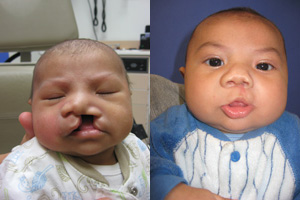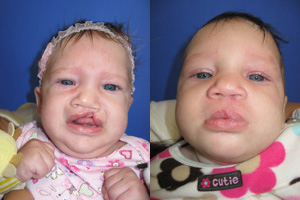Birth Defects Prevention Month: Cleft Lip and Palate

If the lip is open up to and including the floor of the nose (above left), it is called a complete cleft lip.
Parents dreaming of the arrival of a new bundle of joy hope for a healthy baby. Yet, many babies are born with birth defects. According to the March of Dimes, more than 120,000 babies in the U.S. are born each year with a birth defect.
Cleft lip and cleft palate occur in about 1 or 2 of every 1,000 American babies each year, making it one of the most common major birth defects, according to the Nemours Foundation.
Joshua Demke, M.D., Texas Tech Physicians Surgery, assistant professor of facial, plastic and reconstructive surgery, said clefts of the lip could occur with or without a cleft palate. Cleft lip and palate is more common in boys, and isolated cleft palate is more common in girls.
Development and Detection
"In utero an embryo develops rapidly,” Demke said. “Before four weeks gestation it is normal for the upper lip to be cleft. But by seven weeks the lip segments have fused in most embryos to form an intact upper lip. Only when this fusion fails does a cleft lip result."
Clefts of the lip can sometimes be detected in utero using advanced ultrasound technology, but clefts of the palate are rarely seen on ultrasound, Demke said. Knowing about a cleft lip and/or palate before a baby is born enables parents to meet with a cleft team to discuss what to expect, surgery and long-term management.
In most cases of cleft lip and/or cleft palate there are no other abnormalities or genetic problems, Demke said. It is believed that a combination of environmental triggers and underlying genetic factors contribute to clefts, but there are known syndromes associated with cleft lip and/or palate.
"A cleft palate can be a clue to look closely and rule out other abnormalities that might be involved such as heart problems,” Demke said. “A visit with a geneticist can be helpful to make a diagnosis and to help with family planning and understanding risks of inheritance that are not always straight-forward."

Demke said many parents worry when they first see their baby's cleft lip or palate, but they can typically be closed when the child is 2 to 3 months old.
Correction and Prevention
Demke said parents may feel discouraged when they first see their baby's cleft, but should remember cleft lip and cleft palate can be corrected. Cleft lip is typically closed surgically when a baby is 2 to 3 months old, Demke said. Palatoplasty, or surgically closing off and separating the roof of the mouth from the nose, is typically performed when a baby is 9 to 12 months old.
"Operating too early leads to problems with growth restriction of the upper face, and waiting too long can lead to bad speech habits that can be challenging or impossible to overcome,” Demke said. "Children with cleft lip and palate frequently face problems with hearing loss and usually require one or more sets of temporary tubes to help with their ears."
Babies with craniofacial deformities may also have problems with feeding and weight gain, Demke said. Large clefts of the palate can make it difficult for babies to breastfeed because they can’t generate suction, and as a result may require special bottles and nipples.
Uncorrected clefts in young children can result in missing teeth, crowding and cross bites. A bone graft is frequently needed at 7 to 9 years old to stabilize the bone of the front teeth. Braces and palatal expanders are commonly needed to help with crowding and cross bites.
Because neonatal surgery is risky, Demke said his advice to expectant mothers is to do everything they can to prevent birth defects in the first place. He said pregnant women can reduce their babies’ risk of cleft lip and palate by being aware of risk factors including smoking, diabetes, seizure medications, exposure to pesticides, lack of folic acid and alcohol and drug use.
Related Stories
How Does Your Garden Grow?
As spring approaches, some people’s thoughts turn to gardening. Whether it’s a flower garden they desire or a vegetable garden want to have, they begin planning what they’ll plant and what they need to do to ensure a successful garden.
Adopt a Growth Mindset for a Better Life
A “growth mindset” accepts that our intelligence and talents can develop over time, and a person with that mindset understands that intelligence and talents can improve through effort and learning.
Drug Use, Family History Can Lead to Heart Disease in Younger Adults
Abstaining from drug abuse and an early diagnosis of familial hypercholesterolemia (high cholesterol) can help prevent heart disease.
Recent Stories
Texas Tech University Health Sciences Center Expert Elected 2024–2025 American Pharmacists Association House of Delegates Speaker-Elect
The American Pharmacists Association (APhA) announced that Mary S. Klein, Pharm.D., was elected the 2024–2025 speaker-elect of the APhA House of Delegates.
Free Clinic Offered for Women’s Health Day
The Free Clinic, staffed by TTUHSC School of Medicine students, will host Women’s Health Day Clinic from 10 a.m. to 1 p.m. on April 27.
Hutson Named TTUHSC Hematology Oncology Division Chief and UMC Cancer Center Director
Thomas E. Hutson, D.O., Pharm.D., an internationally recognized leader in the field of urologic cancers, has been named chief of the Hematology Oncology Division in the Department of Internal Medicine at the TTUHSC School of Medicine.
